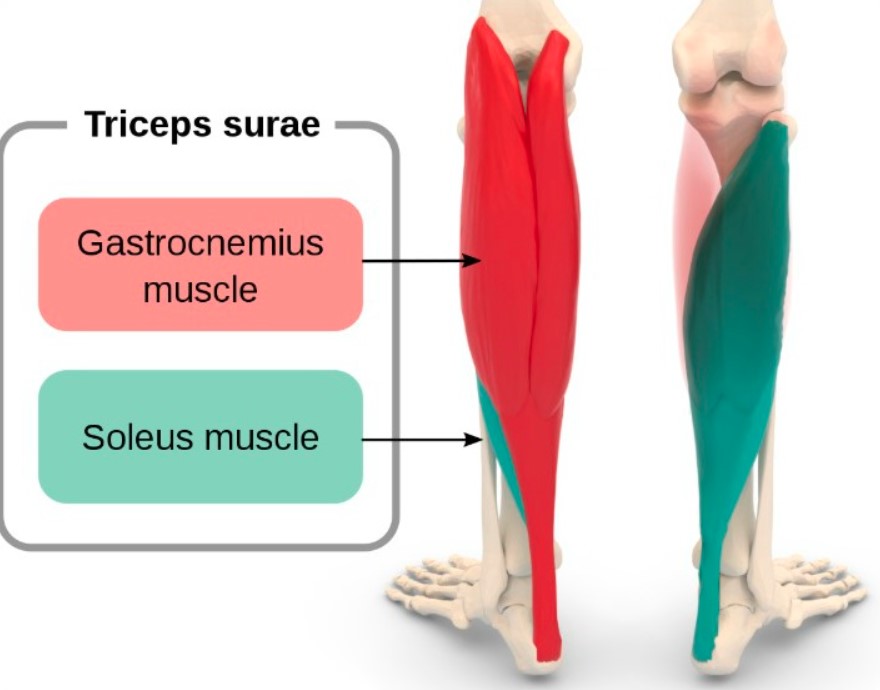Why calves get tight
Humans are upright beings, so our poor calves have to support the load of our whole body weight for however long we’re walking or standing. If you have job that makes their legs stay in a similar position for prolonged periods of time (sitting at the desk, in the car or on an airplane or, standing still), there can be fluid build up around our ankle which makes your calves swollen. Making sure enough magnesium and potassium is one way to reduce muscle soreness and swelling, but that doesn’t mean you can skip stretching and recovery!
Why tight calves are a big deal
You may think “who cares about calves? They’re not abs or biceps…” Sure, while calves are not something we worry about first, for many compound lifts their proper range of motion is essential.
Running
If you’re a runner, you need to land on the on the ball of the foot, right under your center of gravity. Tight calves will cause you to you will toe-strike, and running on your toes is exhausting. Sprinters use it for distances for up to 400m. Anything above this will cause calf overuse.

Lifting
Squats and deadlifts, kettle bell swings, bent over rows and other exercises require you to be able to properly hip hinge. Tight calves will decrease your posterior chain range of motion and open the door for potential injuries.

Calves consist primarily of two muscles on the back: soleus and gastrocnemius on the back, and tibialis anterior – on the front.

Let’s start with gastrocnemius
Gastrocnemius attaches above the knee joint, on the femur, so to stretch it, you’ll need to keep the knee straight. The “pushing the wall stretch” with a straight knee is a good option, hold at least 15-30 sec – it takes time to relax and really sink into the stretch. You can also use an incline surface to stand on if you’re more flexible. No need for huge angles – 20 degrees is plenty. Last, “stair stretch” where you stand on the stair with toe and let the heel sink down is another option.
Soleus
is an “inner” calf muscle that attaches below the knee, so to access it, bend the knee in the same “pushing the wall” position and let the knee drop.

My personal favorite
stretch for both (because my Achilles is flexible and I can afford a steeper angle than a wall stretch). It is an amazing stretch for your whole posterior chain (musculature on the back of the body). However, please be careful – if you’re not too flexible yet, start with placing hands on a wall or a table. Once that’s comfortable – lower hands to a chair, step, and then eventually – the floor.
Compression Socks
Another favorite of mine. Once I’ve learnt the trick of NOT having water-flushed, heavy calves after a long flight, life hasn’t been the same… All you need to do is wear compression socks while flying! They help blood circulation and prevent your feet from getting tired and swollen. Depending on the kind of socks you get – they can be worn from a couple hours to all day. I have medical grade socks which are not super tight and affordable, so if I’m up for a strenuous half-a-day hike, or a flight across the atlantic, you’ll definitely find me wearing them!

Activation
Resisted toe flexion is a great way to activate your calves once you’ve stretched them. Sit on the floor and use a towel or resistance band for this. Repeat with bent knees and straight knees for 2 sets of 20 for each leg. This graphic should help:
 Last but not least – please don’t forget to foam roll your calves all the way from top to bottom! Yes it’ll hurt, but you do get used to it. Self-massage is another option if you don’t have a foam roller.
Last but not least – please don’t forget to foam roll your calves all the way from top to bottom! Yes it’ll hurt, but you do get used to it. Self-massage is another option if you don’t have a foam roller.

